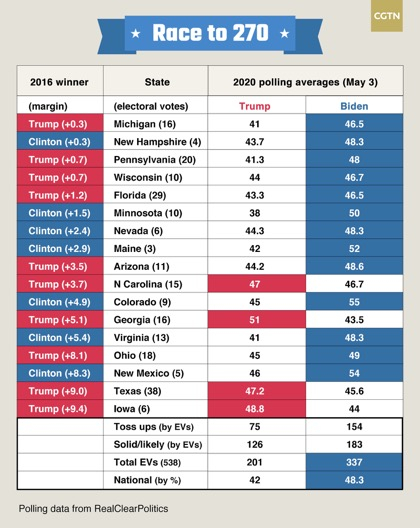If a week is a long time in politics, six months is a lifetime.
But, half a year from the November 3 U.S. presidential and congressional elections, polling indicates a clear trend — subject to numerous caveats.

Joe Biden (L) speaks in Delaware, March 12, 2020, and Donald Trump speaks in Washington, April 5, 2020. /AP
Joe Biden (L) speaks in Delaware, March 12, 2020, and Donald Trump speaks in Washington, April 5, 2020. /AP
Hillary Clinton was in a strong position six months out and Donald Trump won the electoral college, despite losing the popular vote. No one knows how the COVID-19 pandemic will play out in health or economic terms, and Joe Biden has had next to no exposure to-date other than a sexual assault allegation, which he denies.
In addition, a third party candidate like Justin Amash could change the dynamics of the election and quality polling — particularly of likely voters — is limited.
That being said, state-by-state polling suggests that six months before the election the White House is Joe Biden's to lose and Democrats are competitive in the battle for an all-important Senate majority.
The race to 270
The national electoral system in the U.S. weights 538 electoral college votes based on a state's population. Coastal states typically vote Democratic, inland states mainly vote Republican.
That makes it a fairly safe assumption that Donald Trump, targeting 270 electoral votes for a second term, starts with 126 all but guaranteed and Biden begins with 183.
A handful of battlegrounds are in play every presidential election year — voters in these swing states effectively decide who becomes president.

In 2016, Trump narrowly won Michigan, Pennsylvania, Wisconsin and Florida, all by a margin of 1.2 percentage points or less over Clinton. He also took Arizona, North Carolina and Ohio.
But RealClearPolitics 2020 polling averages point to Biden flipping six of the seven battleground states – Arizona, Florida, Michigan, Ohio, Pennsylvania and Wisconsin – while retaining New Hampshire, Minnesota and Nevada, all won narrowly by Hillary Clinton. The polls currently indicate the former vice president could even be competitive in North Carolina and Texas.
If Biden holds the states won by Clinton and flips three of four of the battlegrounds, he will win the election. Should the current polling leads play out on November 3, he would be returning to the White House, this time as president, in January 2021 with an electoral college victory of 337 to 201 to go with a popular vote win of around six points.
The Senate
The Senate, currently in Republican control and the key to judicial appointments as well as passing legislation, is also in the balance.
The Democrats need a net gain of three in the 35 contested seats for a working majority, if Biden is elected, and are defending only 12 seats. The party's candidates are expected to win in Arizona, Colorado and Maine but lose in Alabama, while North Carolina is regarded as a toss-up.
Democrats are heavily out-fundraising vulnerable sitting Republican senators at this stage, and allied with a generic ballot lead — the party people plan to vote for in congressional elections, irrelevant of specific candidates — of almost eight points, according to FiveThirtyEight, the party looks to have a slight edge in the Senate battle and be in a strong position to retain the House of Representatives.
Of course, for all the caveats listed above and more, the current polls should be treated with skepticism. But the trend is clear — six months before polling day, Biden and the Democrats are in a stronger position than Trump and the Republicans.
(Graphic by Li Xiaojie)